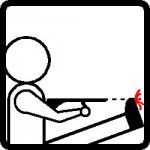When clients ask how to close more sales and free up cash in their business, I like to tell the story of Byron the guns and collectibles dealer. He lives for his business because it gives him the chance to make a living out of doing what he enjoys most: collecting.
He was struggling 12 months ago because he was out of cash and unable to buy new stock. This was a real problem because the strength of his business lay in constantly having new items to show off. New stock encouraged his customers to come back often; no new stock meant they would tend to check out his competitors first.
When I first walked into Byron’s shop, one of the most obvious items was a beautiful old gun, proudly (and securely) displayed in a glass cabinet. I couldn’t help but ask how much it was worth. He explained that it he had bought it for $5,000 dollars, but was looking to sell it for $7,000. Following a hunch that I had hit on his problem straight away, I asked Byron when he had bought the gun. He didn’t remember exactly, he said, but thought it was about five years ago.
I asked Byron how many other, similarly high value items he had in his store. We went for a walk and in the course of showing me around, he pointed out at least a dozen items which he had bought for over $5,000 over the last few years. In each case, he was quick to tell me how much he was intending to sell the item for, and the margin was always 30 to 40%. But the fact was he hadn’t sold these items so they were costing him money and, most importantly, causing him to miss the opportunity of buying new stock.
Byron had spent nearly $100,000 on expensive items over the years. The items were attractive and valuable, but they weren’t particularly rare, so they weren’t appreciating in value significantly. In effect, Byron had put $100,000 on the shelf of his office and left it there for all that time. In other words, while he wasn’t borrowing money from the bank, in effect he was borrowing it from himself. He had missed the opportunity to invest the money somewhere where it would give him a solid return, such as in a term deposit or in blue-chip shares. And he missed the opportunity of using that money to buy smaller, less expensive items that he knew would sell quickly. He needed to do something (and fast) if he wanted to close more sales.
Compounding all of this was the fact that the global financial crisis had caused demand to drop markedly which meant his customers just weren’t coming in or spending as much as they used to.
By making a few simple adjustments, responding to trends in the industry and addressing a need that his customers, Byron was able to turn his business around, close more sales and double his bottom line.
The first thing he did was to free up some cash by actively selling some of his more expensive and slow moving items. He used online auction sites and his own network to find buyers, while keeping his marketing costs low. In some cases he had to sell the items for a little less than he had intended, but the benefit (when he was able to close more sales) was cash in his pocket.
The next thing he did was set up some systems to keep better track of inventory. He started by recording everything and noting the age of all the items (i.e. the length of time he had held it in stock). We agreed that in future, any item that had not sold after 8 months would be reviewed. Byron would investigate the item’s market value and decide whether or not it was increasing in value sufficiently to be worth keeping. If not, he would act to move the item on.
After a few months, Byron was making much smarter purchasing decisions. He was still enjoying ‘collecting’ for his store, but his focus was different. His focus was less on attractive, expensive but not-so-rare items, and more on smaller items he knew he could sell quite quickly. To his pleasant surprise, he increased cash flow by $100,000 in 3 months and found that by using this strategy, he was able to do more shopping rather than less, because he had more cash available to spend.
Lastly, but perhaps most significantly, Byron introduced 2 new complementary strategies which literally transformed his business. To counteract the soft demand for firearms and the relatively fixed, low margins, Byron convinced his customers to purchase 18 months worth of ammunition upfront and he provided storage (if required) onsite. This allowed him to renegotiate terms and pricing with his suppliers, plus generate more cash flow in the short term. Since the margins on bullets was much higher than on the guns themselves, his overall profitability improved. In addition, Byron incorporated training and certification into his standard offering and opened up his target range to paying customers 3 nights a week. This allowed him to create new, highly lucrative income streams and increase the frequency with which his customers came into his business.
While Byron’s story on how to close more sales might seem unique and industry specific, there are many ways to take the overarching philosophy of what he did and utilize it to improve your operating cash position.
How can you identify and start selling silver bullets in your business? Begin by first examining the big picture…
Identify the items in your inventory that are essentially dead stock – i.e. haven’t sold in over 8 months. Determine what the total value of the stock is and devise a plan to convert it quickly into cash using a minimal amount of advertising.
Focus on the gross profit margin of all of your products and services. Are some of these more profitable than others? To improve your overall performance, concentrate on the former, and improve or eliminate the latter. What items or services could you add which would allow you to service a need, improve your relationship with your customers and grow your bottom line?
Negotiate better terms and/or prices with your supplier in order to increase the amount of gross profit you make on each sale. Consider which items you could sell in bulk upfront to your customers and use this new volume to improve your buying leverage or cut out the middle man.
Marketing should not be treated as a fixed and sacred cow in your business. Do not spend another dime on marketing until you ensure that you are maximizing the amount you retain on each sale to cover fixed costs. Also, only spend money chasing customers and sales if you can measure the financial return that you will get. Unless you are a multinational brand, money spent solely on branding is wasted.
Make it easy for your customers to find you and see what you have to offer on the internet. The database of potential shoppers that you have earned the right to speak to, is in fact your greatest asset. What can you do today to add value, enhance their experience and close more sales?
Finally, examine the fixed expenses in your business. Identify whether or not there is a cheaper, faster or superior alternative that doesn’t compromise quality or customer service. Is there a way to shift how and what you do so that fixed expenses can vary (i.e on a pay per use basis) with the level of production and/or sales? And remember, no one has ever grown their business by [exclusively] focusing on cost cutting – so use this tactic as your final step in a comprehensive plan to get your business firing and hitting targets. Your primary goal is to close more sales and increase the amount of gross profit (or contribution margin) that you make from each sale.
09 Nov 2011
8 Ways You Sabotage Your Own Success in Business
As a business owner, I’ll bet you’re incredibly busy and find that there never seems to be enough hours in the day to complete all your work.
Have you ever noticed that some of your everyday activities are just deeply ingrained habits – driving your car, putting on your watch, brushing your teeth or taking a shower? You wouldn’t dream of not doing them, they are part of your routine and they just seem to happen automatically. In your business you also have habits such as checking your website, opening the mail, reading emails, grabbing a coffee and glancing at your diary. You do them without conscious “thought” and they seem to fill up hours in your day…
But what about all the actions you need to take in order to build a more profitable and efficient business? Like following up with your best customers, asking for referrals, strategic planning and goal setting to grow your business? When do you do these activities? Do they often get relegated to “tomorrow” or “sometime soon”?
If you’ve ever spent your day stuck in back to back meetings, answering routine questions from your team, responding to emails, helping other people, doing paperwork or tidying your office – you already know that these are “make busy” activities, and they will keep you trapped where you already are – just simply maintaining, not growing your business. By filling your days with these tasks, you are in effect avoiding the very activities that you know will really move your business forward and produce tangible results.
Your “make busy” work or habits create the magnificent illusion that you are hard at work, simply because you feel “flat out” and your day is full of tasks. Let’s be honest, you would actually rather do anything than face the activities you know would radically accelerate your business success NOW! In fact, you often get to the end of the day and say to yourself “It’s OK, I was really busy, I’ll just get to that marketing plan tomorrow.” Or “I just couldn’t find the time today to make that seminar on leadership or customer loyalty.”
If you are waiting for the right or best time to do these critical activities in your business, it will simply never come! There will always be other “busy work” to fill all of your available time. You need to find a way to make your business building activities an ingrained habit too, if you want to grow your bottom line and live the lifestyle of your dreams.
Do you relate to or identify with any of these common sabotage habits?
1. Perfectionism – this tactic is insidious. It often immobilizes us from making a decision, starting a project or activity and signing off on a piece of important work. Most tasks don’t have to be 100% perfect, they just need to be good enough. The other way that this can show up is when you deceive yourself into believing that no-one else can do the job (even simple routine tasks) to your exacting standard, so you must do it ALL yourself. Follow the 80/20 rule, delegate what you do not have to do yourself and give yourself permission to be human!
2. Refusing to Let Go of The Past – Have you ever heard yourself say “last time I tried that, it didn’t work”? Or have you ever simply avoided doing something that you know you should or need to do but were afraid to do because “last time it didn’t work out the way you wanted it to”? Even though it’s a good idea to stop doing what clearly doesn’t work, it’s important to remember that the past does not necessarily equal the future. If you catch yourself finding reasons from the past to justify why you are not moving ahead toward your compelling future, stop NOW and take a good hard look at whether these are just cleverly disguised forms of self-sabotage.
3. Lack of Accountability – who is holding you accountable to the decisions you make and the actions you take in your own company? Isn’t that why you went into business for yourself in the first place – so that you could be the boss and do things your way? Find someone outside your business – a coach, mentor or trusted advisor that can act as a sounding board and hold you accountable to staying on track.
4. Lack of vision, planning and specificity – if you don’t know where you are going, how will you know when you get there? Enough said. If you don’t have a 90 day, 1 year and 3 year business plan, you need to make this your number one priority in your business. Set a weekend aside and find a place where you will not be disturbed by anyone or anything. Set down your goals clearly and succinctly – get clear about the specifics (who, what, where, when and why) and set realistic deadlines for completion. Goals need to be written down in detail to allow your mind – which is a goal seeking mechanism – to do its magic.
5. Lack of focus – stay focused on the important task you are currently working on and only allow yourself to be diverted by real emergencies.
6. Fear of Financials – you cannot have a truly successful business if you don’t know your numbers. Not knowing your numbers has already cost you time and money. Find someone who can explain your financials to you in plain English – learn the key drivers and indexes in your business (such as break even, productivity ratios, inventory turns, gross profit margins etc.) and track them daily.
7. No USP – the greatest product or service in the world will not sell if you have not clearly defined why someone should buy from you instead of your competitors. “Build it and they will come is a fallacy.” If you have not yet figured out what is unique about your product or service and found a compelling and cost effective way to communicate it in everything you do, you are literally flushing your marketing budget down the toilette.
8. No Testing and Measuring – this is the most-often overlooked activity by small business owners. The simple act of testing and measuring everything in your business…and I mean everything…will save you thousands of dollars this year. No matter what “it” is, if you haven’t tested and measured “it”, you don’t really know if “it” works. And until you know if it works, you don’t have a reliable, predictable business that will run without out.
Unfortunately, there are no quick fixes. As you already know or suspect, some of the most common forms of self-sabotage are habits because they are deeply ingrained behaviours that take time to establish or eliminate. In the 1960’s a highly regarded plastic surgeon, Dr. Maxwell Maltz discovered that it took 21 days for amputees to cease feeling phantom sensations in their amputated limb. From further observations and significant research he established that it takes 21 days to create a new habit.
Brain circuits take engrams (which are essentially “memory traces”) and produce neuroconnections and neuropathways only if they are bombarded for 21 days in a row. This means that our brain does not accept new data or information for a change of habit unless it is repeated each day (without fail) for at least 21 days. Changing habits (whether positive or negative) can be done but it takes time and consistent effort.
Do yourself a favour and identify today which form of self-sabotage is the primary one that is holding you back from having the business and lifestyle of your dreams. Make a plan on paper – specific decisions and actions that you can take to move forward in this aspect every single day for the next month. It is imperative to track your progress each day and I highly recommend finding an objective person outside of your business to hold you accountable to your plan, actions and results.
Is your business growth starting to plateau or stagnate?
It’s easy to sit back, take the foot off the accelerator and watch the sales roll in, especially if you’ve been satisfied with your recent performance. But keep in mind that if you slack off too much, your competitors will soon catch up and eventually put you out of business.
Take a look around – businesses (and your competitors) are closing their doors due to the drop in consumer spending – which means MORE potential customers for businesses like YOU, that do survive. Today is the best time to take steps to revamp your marketing efforts and respond to the needs and the pain of your target market.
In these tough times, it’s going to take more than “thinking outside the box” and goodwill with existing customers to secure the survival of your business.
I want you to STOP right now and make a list of everything that you (and your competitors) do NOT do to make it easy for your prospects to buy from you. If you want to succeed over the long term, you will take a good hard look at both of these lists and find a way to do whatever it takes, for as long as it takes, to win your customers and keep them.
Granted, this is not an easy task. Most businesses will continue to do what they have always done – guess or assume what they think their customers need. However, no matter how challenging it is to ask the hard questions and re-engineer your strategy, I guarantee it will be a whole lot less painful and stressful than going under.
I had a married couple come to me once for advice and coaching – both the business they were in and their relationship were at the breaking point. The husband turned and said to me “I don’t understand it. I do everything humanly possible for my wife and she doesn’t appreciate me and I don’t think I can possibly do anything more to satisfy my customers – they are never happy and always want more. What can I possibly do?”
My answer to this age old dilemma applies to him, his marriage, and to you in your business right now. “Sounds like you are doing a lot. Too bad it’s everything BUT the very thing that your partner and customers need most.”
While this may sound harsh, I think you will agree that it is absolutely true. It does you no good to work harder doing everything…instead of focusing on the 1 thing that you customers actually need. Wouldn’t it be easier for you to work smarter, not harder, if you knew with absolute certainty what that 1 thing is?
How can you take the lesson from my client and apply it to your own business right now?
How could you go about figuring out what that 1 thing is?
I want you to do something really radical today and start asking both your prospects and existing customers what they need. You need to find out:
• What is the biggest challenge your prospects are facing in their business?
• When your customer thinks of the product or service you provide, what is THE most painful or difficult issue associated with acquiring it?
• What is the most important criteria to your purchaser when evaluating a company like you?
• What are some things that he/she thinks about or considers from a financial perspective when selecting that product/service or a vendor?
• What is the key strategic driver for you customer’s decision?
It doesn’t really matter what you have done up to this point or how hard you are working. There is no prize for volume or quantity. What counts is quality and relevance.
Are you giving your customers what they want and are you willing to do whatever it takes to help them cure the pain that they are in?
More of the “same old same old” is not going to differentiate you from the pack, build trust, win customers and grow your business. Take some time today to really think about what you offer and how it could be improved to meet the primary need of your customers. If all of your customers were to leave today, what would you need to change in order to win them back and survive?
At the end of the day, price is never the determining factor. Once you uncover the true cost of the problem they are facing, price becomes irrelevant. Your customers will always be willing to pay a fair price for a product/service that cures their pain – not to mention the peace of mind that comes with excellent service. Take stock of what the competition is NOT willing to do and what your customers wnat most from you.
Do something unique – listen and be willing to do whatever it takes to deliver what they want (and need). Anything less, is simply a waste of your time and money on everything that doesn’t really matter.
Article Source: http://EzineArticles.com/6586203
02 Oct 2011
10 Proven Ways To Improve Your Business Today!
It doesn’t matter whether it is springtime or autumn where you live – the best thing that you can do to improve your business right now is a bit of spring cleaning.
By this of course, I mean reinvigorate some of the housekeeping issues that you may have overlooked in recent times. Over the last few years you may have found it possible to get away with a few loose ends and haphazard processes, but not any more. The tough economic times have changed all of that. It’s time to get serious about tightening up your systems and securing your future. Here are my Top 10 Tips to improve your results:
1. Have a plan
Position your business for the year ahead. Decide on your strategy, set your goals and work on your tactics. Put these together in a one or two page business plan. Uncertain times call for certain actions.
2. Forecast your cash flows
Maintain a cash flow forecast so you can use it as an early warning system. The sooner you get an indication that your cash is tightening the more time you will have up your sleeve to take action.
3. Collect your debtors more quickly
On average how long do your debtors take to pay you? Aim to reduce this by at least 10 days – if your annual revenue is $1 million you could save yourself $3,000
4. Reintroduce credit checks
Have you got a bit lazy about running credit checks? Reintroduce them.
5. Monitor your customers debtor history
Are any of your customers starting to take more credit than usual? Keep a close eye on them. They could be feeling the squeeze so be careful about extending too much credit.
6. Evaluate your customers
Do you know who your best and worse customers are? How much profit are you making from each customer? If you don’t know, now is the right time to set up systems to track this and….
7. Cull your bottom customers
Harsh as it may sound, concentrate on your best customers. Lavish them with attention. If you have unprofitable customers, cull them. You have no room for passengers.
8. Trim your product range
If you are carrying a wide range of stock trim it. Do this by calculating which of you stock lines are your worst performers; sell those lines quickly to release some cash. Reduce your overall investment in stock.
9. Look at your processes
Mistakes are costly so take a look at your processes. What can you tighten up or do differently to lower the chance of errors?
10. Have a budget
Having a budget isn’t about cutting costs, it is about managing costs. So budget your expenditure for the year and track your actual costs closely. If you see costs starting to climb take steps to reduce your non essential expenditure.
So in the face of rising interest rates and a global economic downturn the best thing that you can do to improve your business is to tighten up your belt and the system in your operation.
Article Source: http://EzineArticles.com/5442279
18 Sep 2011
Is Bottled Water Making You Stupid?
Bottled water is THE most profitable drink product in the world, selling for 3000 to 9000 times what you pay for the perfectly safe, inexpensive liquid that comes out of your tap at home.
To put this in context, paying $2.40-3.90 for a 750ml bottle of water is equivalent to:
• $10,000 for a tuna sandwich at your local cafe or
• A bill from your water company this month for $3000/tonne of water (as opposed to the going rate of $1.2/tonne)
According to the Australasian Bottled Water Institute, Australians consume over 250 million litres a year at a price of $385 million. We have been systematically brainwashed by the beverage industry to believe that our tap water is somehow unsafe or insufficient – look around and you will see that there are now hundreds of brands competing for your attention with clever marketing campaigns designed to scare, seduce and mislead you to part with your hard earned money.
Despite its association with prestige, purity and pristine conditions, bottled water is often no better than tap water (in terms of taste and cleanliness) and the production process it is extremely harmful to our environment.
Did you know that:
• For every 250 million litres of bottled water, it takes 125million litres of oil to produce the plastic bottles, refrigerate and ship them from one part of the world to another
• For every litre of bottled water sold, another 2 litres are used up in the production process
• More than ½ of the brands on the market are derived from municipal water supplies, despite the fact that the packaging would lead us to believe they come from unspoiled mountain streams or underground springs
• Over 80% of the bottles end up in landfills and are never recycled
It is estimated that bottled water has become a more than $45 billion dollar industry worldwide. Surprisingly, 97% of it is consumed in countries which have plentiful sources of clean, safe drinking water. We can afford to turn our noses up, avoid the tap and fork out millions for bottled water: our choice however is purely a lifestyle one. A lifestyle choice for us with life and death consequences for others and our planet.
For 2.6 billion people in the developing world, lack of clean water and basic sanitation is a life or death situation. It is estimated that half of the people in the developing world are suffering from diseases associated with inadequate water or sanitation and that 5 million people die each year. According to the International Water Management Institute, clean water and improved sanitation could be provided to everyone on earth for an outlay of $11 billion a year (less than a quarter of our global $45 million spending on bottled water), yet to date, there has been no impetus to re-channel the money and change our thinking on this important issue.
So you may be sitting there and thinking, what does this mean for YOU and your business?
Well, nothing… and yet perhaps, everything.
How often have you (or someone else in your team) said:
• “if we had more money, we could invest in X and improve our business?”
• “if we put our prices up by 10%, we will lose customers.” or
• “we can’t afford to buy X because it’s too expensive.”
You already have enough money to do and buy all of the things that you need – it’s simply a matter of common sense and priorities. We are all affluent in this country: It is your mindset and your language which is lacking, not your bank account.
In fact, each and every day you and I waste money by overpaying for bottled water and other convenience/impulse items. We rarely stop to think about the true value of what we got vs. what we paid. Bottled water is just one obvious example and it is not difficult to see how this might be playing out in other areas of our lives.
You and I have happily overpaid for products. Yet we struggle to charge what we are worth or put our prices up because we fear that no one will buy. Isn’t that interesting?
Perhaps you and I need to take a lesson from the bottled beverage industry and focus on how we are marketing and selling our products/services? Is fear more powerful than selling benefits? Is perception more influential than reality? Are you seducing your customers with sizzle or merely putting them to sleep with your low prices?
Think about it. Beverage companies have managed to package and sell to us something that is practically free and plentifully abundant, for thousands of times what it is worth. And up until now, we have all paid willingly. Bottled water has in fact made us all look a bit foolish.
Maybe it’s not the price you are charging that is the problem? It’s the way you are choosing to promote your product/service. The best time to change your mindset and your approach is now. Anything is possible.
Article Source: http://EzineArticles.com/4936397















